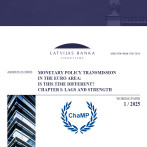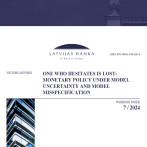Sunshine after the rain: pension plans in 2023

In short
-
After the substantial asset value decline in 2022, last year the State-funded pension scheme (VFPS) delivered the highest return since 2009: 12.3%.
-
Return-wise, the increasingly popular active 100% (equity) plans were the top-performers.
-
As most managers employ the index replication strategy, I expect the VFPS to keep closely following the global financial market benchmarks in the future.
-
The passive approach and the expanding assets of the VFPS suggest that management fees should continue to decrease. Likewise, participants should ensure that the chosen plan matches their age and desired risk and return level. This will be salutary to the overall system performance.
For the global financial markets, 2022 was among the worst years since the beginning of the century. The war in Ukraine, the sharp inflation rise, and the response of the leading central banks – higher interest rates – led to lower bond and company stock prices. As I wrote a year ago, these developments directly affected the State-funded pension scheme (also known as the second pension pillar, abbreviated as VFPS) plans. The average plan's share value that year decreased by 13.8% (Chart 1).
In this article, I will examine the VFPS' performance in 2023, its causes, as well as suggest how the system can be enhanced further.
Inflation down, sentiment up
Despite unpleasant feelings the plans' participants might have experienced in 2022, a year ago I urged not to rush into thinking about switching to a different pension plan. Historically, after all market downturns, there have been rises that more than compensated for the initial fall. Although no one, myself included, can perfectly predict financial markets developments, by the end of 2023, most of the "average" plan's loss in nominal terms has been compensated (Chart 1).
Last year's positive result reflects the upswing in the international financial markets, triggered by the rapid deceleration of inflation. In January 2023, the annual consumer price inflation was 8.6% in the euro area and 6.4% in the US. By the end of the year, in December, it had fallen to 2.9% and 3.4%, respectively. Such significant progress in the fight against inflation and the approach towards the 2% inflation target set by the leading central banks improved the mood of financial market participants. The realisation that interest rates might have reached the peak of this monetary cycle and could be reduced in 2024 bolstered asset prices.
Financial market participants' expectations of lower interest rates mean cheaper borrowing and faster economic growth. Mechanically, this is reflected in higher bond prices, as well as higher corporate stock prices, as earnings prospects improve and future profits become more valuable in today's terms.
As a result of these developments, the world equity index [1] increased by 18.1% in euro terms in 2023, and the European bond index – by 7.2%. [2]
Equity plans produced the highest returns
Similarly to 2022, in 2023, global indices described changes in the plans' share value very well. The "average" plan, weighted by assets under management, posted a 12.3% return for its participant, which is the second-best result in the history of the VFPS and the best in the last five years (Chart 1). Active 100% (equity) plans, which invest nearly all of their participants' money in company stocks, showed an 18.1% increase in share value, while conservative (bond) plans delivered a 7.3% increase. Other plan types, which invest in stocks and bonds in various proportions to manage risk, generated a return that was in between that of the active 100% plans and the conservative plans (Chart 2).
It should be noted that such distribution of returns is not surprising. On the contrary, it reflects a normal market situation where an investor expects a higher return from stocks than from bonds, but is willing to take on greater risk (return volatility) for it.
The VFPS plans in 2023 are a very good example of this principle. In Chart 3, on the y-axis, I put the annual return on each pension plan and on the x-axis – the volatility of return (measured as standard deviation). I mark the plans belonging to the same plan type with a single colour. As can be seen, the active 100% plans, which invest almost solely in stocks, provided the highest return and also exposed its participants to the greatest risk. Meanwhile, the return on and volatility of conservative plans were the smallest. The values for the other plans ranked in between according to the share of stocks in the portfolio – the larger it is, the higher the risk and return are.
Equity plans are getting more popular
It can be inferred from Chart 3 that a higher return does not automatically mean that a plan is "better". When choosing a pension plan, both return and risk should be factored in.
Due to legislative restrictions, historically the VFPS has been very conservative. Until the beginning of 2018, the total share of stocks in the plan could not exceed 50%, and so active 50% plans were prevalent. At the beginning of 2008, three out of four participants chose such plans (Chart 4). Conservative (bond) plans were also relatively popular, partly because all those who started working and did not choose another plan were automatically assigned to these plans.
In 2018, the limit for stock investments was raised to 75%, and in 2021 it was abolished altogether. As a result, plans that invest up to 100% of assets in stocks gradually emerged. Since the introduction of these plans, their popularity has surged. Currently, almost 29% of participants choose them.
As seen in Chart 4, 100% plans are primarily taking over the popularity of the 50% plans, but also the balanced and conservative plans. There is reason to believe that this trend will continue. In their communication, many managers recommend choosing the most active plans up to the age of 50–55. The current Cabinet Regulation on the operation of the VFPS also stipulates that new participants up to the age of 55 are randomly assigned to one of the 100% plans.
I believe that the transition to more active plans will also be facilitated by the amendments adopted at the end of 2023, which require managers to individually provide information to their plan participants on whether they have chosen the plan most suitable "for their age and needs".
In Latvia, approximately 74% of all the employed are under the age of 55, which is more than double the current proportion of participants choosing active 100% plans. This suggests that the market share potential of these plans is far from exhausted.
Assuming that stock returns continue to be higher than those of the bonds, a larger proportion of participants in equity plans could significantly improve the overall return on the VFPS. For instance, if three out of four participants had chosen one of the active 100% plans and the rest had joined balanced plans, the return in 2023 would have been around 15.5% instead of the actual 12.3%.
It is important to remember that these are theoretical calculations and the future development of financial markets is never precisely known in advance. Admittedly, a larger share of stock investments also means greater potential for losses during market downturns.
Lower fees can boost returns too
Both the value loss in 2022 and the increase in 2023 are not the result of particularly original asset management. The plans are mostly managed very passively, i.e. managers replicate global indices.
The extent to which indices can explain changes in the value of pension plan shares is evident in Chart 5. Conservative plans obviously replicate the fluctuations of the European bond index, while the active 100% plans are almost a perfect copy of the global equity index. This visual similarity is confirmed by the correlation coefficient, which is numerically measurable from 0 to 1. For conservative plans, the correlation of value changes is 0.84, and for stock plans, it is 0.95. [3] A similar comparison can be made for other plan types, but it is complicated by the fact that the share of equity in each plan can vary within a 25 percentage point range.
What does this close correlation mean for the average VFPS participant? There are at least two aspects – one positive and one negative, as well as a remark.
The negative aspect is that the relatively small effort by pension managers can only justify a minimal fee (commission). For a long time, VFPS commissions were disproportionately high – up to 1.56% of average assets per year (Chart 6).
At the beginning of 2018, the amendments to the Law on State Funded Pensions came into effect, imposing stricter caps on management payments and effectively reducing them to 0.4–0.6% of assets per year. However, with the continuously increasing asset value (thus a larger base from which compensation is calculated), participants – future pensioners – could expect further fee reductions, rather than the stabilisation around the legal limit. Potential extra savings (for example, due to fiercer competition or even stricter caps), based on the experience of other countries, could amount to up to 0.2 percentage points per year. Due to compound interest, such a difference can significantly affect the value of the savings in the long term.
The positive aspect, in turn, is that the index strategy has historically shown very good performance, and outperforming it is indeed a difficult task. This fact made the approach omnipresent around the world. Since 2001, the global equity index has had an average return of 5.3% per year, and the US stock market since 1928 – an average of 7.3% per year. Like any other investment, this strategy does not guarantee positive return, but its inherent diversification and historical results make it a very sensible choice.
An important remark here is that the correlation between indices and pension plans is close but not absolute. Partly, this is because managers invest in the local capital market and so-called alternative investment funds. Although such investments constitute a very small part of all investments, they foster the development of Latvia's financial markets, which benefits the country's economy in the long term. Even with this positive side effect in mind, with the current commissions, plan participants should demand either significantly more active management and consequently higher returns, or lower commissions for passive management.
To conclude
After the financial "rain" of the year before last, in 2023 we saw the sun rays again, pleasantly "warming up" the pension plans. Even in its existing configuration, the VFPS can provide results close to those of the global benchmarks, which in the long term will significantly support the first pension pillar, affected by the demographic crisis, and will form an increasingly larger part of the monthly pension. At the same time, it is important to continue to improve the system. Quick, noticeable improvements can come from more interest by the participants themselves. I thus encourage you to make sure that your chosen plan matches your age and risk appetite.
[1] I use simplified index names: World equity (EUR) – MSCI ACWI Net Total Return EUR; European bonds (EUR) – Bloomberg EuroAgg Net Total Return Index Value Unhedged EUR; US equity (USD) – S&P 500 Index Net Total Return USD.
[2] In this article, by return I mean nominal return, i.e. return before inflation. I also assume reinvestment of dividends after tax (net total return).
[3] Correlation is calculated using a 7-day moving average and taking index fluctuations with a two-day lag.
Textual error
«… …»






